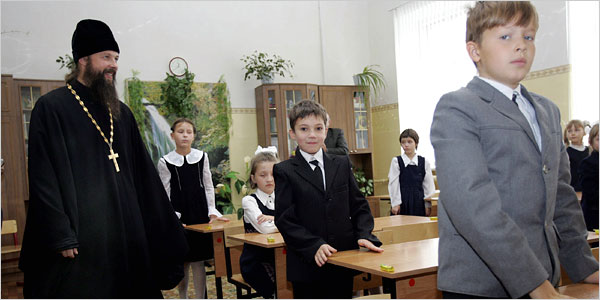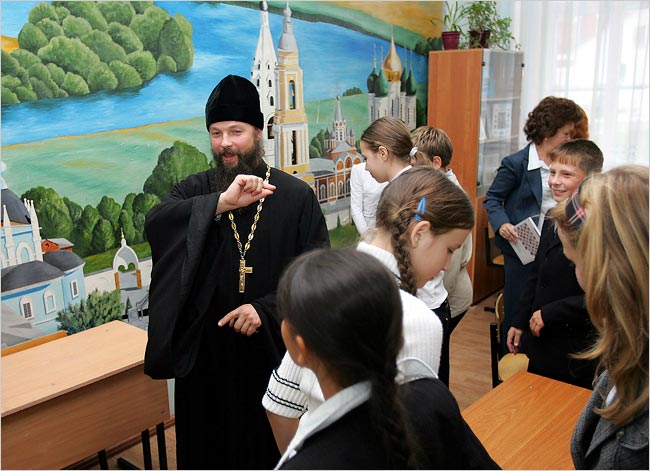Welcome or Not, Orthodoxy Is Back in Russia’s Public Schools
1 Νοεμβρίου 2009
Sergei Kivrin for The New York Times
KOLOMNA, Russia — One of the most discordant debates in Russian society is playing out in public schools like those in this city not far from Moscow, where the other day a teacher named Irina Donshina set aside her textbooks, strode before her second graders and, as if speaking from a pulpit, posed a simple question:
“Whom should we learn to do good from?”
“From God!” the children said.
“Right!” Ms. Donshina said. “Because people he created crucified him. But did he accuse them or curse them or hate them? Of course not! He continued loving and feeling pity for them, though he could have eliminated all of us and the whole world in a fraction of a second.”
Nearly two decades after the collapse of the Soviet Union and the return of religion to public life, localities in Russia are increasingly decreeing that to receive a proper public school education, children should be steeped in the ways of the Russian Orthodox Church, including its traditions, liturgy and historic figures.
The lessons are typically introduced at the urging of church leaders, who say the enforced atheism of Communism left Russians out of touch with a faith that was once at the core of their identity.
The new curriculum reflects the nation’s continuing struggle to define what it means to be Russian in the post-Communist era and what role religion should play after being brutally suppressed under Soviet rule. Yet the drive by a revitalized church to weave its tenets into the education system has prompted a backlash, and not only from the remains of the Communist Party.
Opponents assert that the Russian Orthodox leadership is weakening the constitutional separation of church and state by proselytizing in public schools. They say Russia is a multiethnic, pluralistic nation and risks alienating its large Muslim minority if Russian Orthodoxy takes on the trappings of a state religion.
The church calls those accusations unfounded, maintaining that the courses are cultural, not religious.
In Ms. Donshina’s class at least, the children seem to have their own understanding of a primary theme of the course. “One has to love God,” said Kristina Posobilova. “We should believe in God only.”
The dispute came to a head recently when 10 prominent Russian scientists, including two Nobel laureates, sent a letter to President Vladimir V. Putin, protesting what they termed the “growing clericalization” of Russian society. In addition to criticizing religious teachings in public schools, the scientists attacked church efforts to obtain recognition of degrees in theology, and the presence of Russian Orthodox chaplains in the military.
Local officials carry out education policy under Moscow’s oversight, with some latitude. Some regions require the courses in Russian Orthodoxy, while others allow parents to remove their children from them, though they rarely, if ever, do. Other areas have not adopted them.
Mr. Putin, though usually not reluctant to overrule local authorities, has skirted the issue. He said in September that he preferred that children learn about religion in general, especially four faiths with longstanding ties to Russia — Russian Orthodoxy, Islam, Judaism and Buddhism. But the president, who has been photographed wearing a cross and sometimes attends church services and other church events, did not say current practices should be scaled back.
“We have to find a form acceptable for the entire society,” he said. “Let’s think about it together.”
Polls show that roughly half to two-thirds of Russians consider themselves Russian Orthodox, a sharp increase since the demise of the Soviet Union in 1991. Clergy members frequently take part in government events, and people often wear crosses. But Russia remains deeply secular, and most Russians say they never attend church.
About 10 to 15 percent of Russians are Muslim, most of whom live in the south, though Moscow and other major cities have large Muslim populations. With emigration and assimilation, the Jewish population has dwindled to a few hundred thousand people, of 140 million. Muslim and Jewish leaders have generally opposed Russian Orthodoxy courses, though some say schools should be permitted to offer them as extracurricular activities.
“We do not want Muslim children forced to study other religions,” said Marat Khazrat Murtazin, rector of the Moscow Islamic University. “Muslims should study their own religion.”
During imperial Russia, the Russian Orthodox Church wielded enormous influence as the official religion, and virtually all children took a Russian Orthodox course known as the Law of God.
One of the scientists who signed the letter to Mr. Putin, Zhores I. Alferov, a recipient of the Nobel Prize in Physics in 2000, said he feared that the country was returning to those days. He recalled that his own father had to study the Law of God under the last czar, Nicholas II.
“The church would like to have more believers,” said Mr. Alferov, a member of Parliament in the Communist bloc. “But they can have their religious schools and their Sunday schools. In normal government schools, absolutely not.”
Patriarch Alexy II of Moscow, leader of the church, has repeatedly asserted that to appreciate the arts, literature, heritage and history of Russia, children need to know about Russian Orthodoxy. He described the scientists’ letter to Mr. Putin as “an echo of the atheistic propaganda of the past.”
Five years ago, Kolomna, 60 miles south of Moscow, was one of the first cities to take up the curriculum. Local church and education officials noted that before the revolution, Kolomna was a Russian Orthodox center, site of many cathedrals and monasteries that were demolished or used as warehouses and the like under Communism. Given the area’s history, they asked, is it not fitting that students learn about Russian Orthodoxy?
“The goal, I would say, is that all the powers that be, the church and the government, make sure that people, children, know their history and their roots,” said the Rev. Vladimir Pakhachev, a church leader here who helps oversee the curriculum.
For example, Father Pakhachev said, it would be absurd to study the Russian language without learning about SS. Cyril and Methodius, the two ninth-century brothers who are credited with helping to create Cyrillic, the alphabet used in Russian. The brothers were monks and significant religious figures, and that aspect of their lives cannot be ignored, he said.
At Public School No. 3 here, in the shadow of a restored cathedral, the courses are voluntary, but occur one period a week during the school day, and are taught by regular teachers. No parents have ever asked that their children be exempted, said a school official, Anna Kikhtenko.
“No rights are being violated,” she said. “Children from Muslim families, the parents often say, ‘We are living among Russian Orthodox people. We also want our children to understand what these beliefs are about.’ ”
Recently, Oksana Telnova, a sixth-grade teacher, described to her class how Grand Prince Vladimir introduced Orthodox Christianity to Russia in 988 after rejecting other religions, an event that the church calls the Baptism of Russia. Some children read aloud verses from the Bible.
“Sacred orthodoxy transformed and revived the Slavic soul after becoming its moral and spiritual foundation,” Ms. Telnova said, quoting Patriarch Alexy II. “Through the ages, Christianity helped to create a great country and a great culture.”
Nearby, Ms. Donshina, the second-grade teacher, led her students in reciting the Ten Commandments before pointing to a tiny tree at the front of the room with branches but no leaves.
“Faith in God is as important for every human as the root for a tree,” she said. “But our tree unfortunately has died just like a human soul can die without doing good. This is what happens to people who do not do good things and do not follow God’s laws.”
She asked the children to choose from a group of flowers, some with Christian virtues written on them, some with undesirable qualities, and attach those with the virtues to the tree.
She ended with a discussion of the Russian saints, saying that they “have shown us how one must live to be close to God.” With that, she dismissed the class, but not before giving a piece of chocolate to each child.
Source: The New York Times





